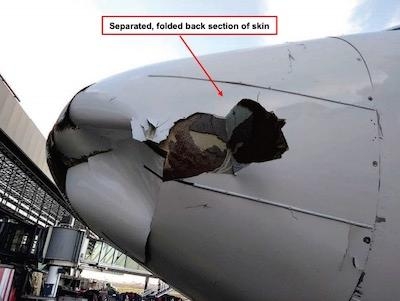Radome On Aeromexico 737 Most Likely Suffered An Internal Collapse Because It Was Installed Improperly
An important development has happened for everyone concerned about the safety of drones.

Back in December 2018, the pilots of an Aeromexico 737 heard a loud bang while preparing to land in Tijuana, Mexico. The radome at the front of the jet was badly damaged, but there was no evidence of a bird strike. Many observers quickly concluded it had struck a drone.
But that wasn’t true. The DJI blog reports that Bloomberg News recently published the results of a Boeing investigation on behalf of the U.S. National Transportation Safety Board, which concluded the radome most likely suffered an internal collapse because it was installed improperly. Boeing’s engineers ruled out any collision with an object. For good measure, the Feather Identification Lab of the Smithsonian Institution found no evidence of bird DNA or feathers on the radome.
This wasn’t the first time that the world’s media have reported a drone collision with an airplane that was later disproven. Instead, it’s at least the seventh time – and it’s at least the second time that a radome’s structural collapse was wrongly blamed on a drone.
For all the good that drones are doing around the world, from taking amazing pictures to saving lives, some people persist in thinking drones are a hazard in the skies. DJI has collected dozens of examples from around the world of alleged drone sightings, near-misses and collisions that are probably – and in some cases definitely – not true. You can read about them in “Elevating Safety,” DJI's report on how to safely integrate drones into the airspace. On page 15 of the report are details about how drones have been blamed for near-misses and midair collisions that were really caused by birds, bats, balloons, a plastic bag, and structural failure.
“Elevating Safety” documents how aviation regulators in the United States, United Kingdom and continental Europe maintain lists of complaints about drones that they know are inaccurate. It investigates years of media reports about incidents that were blamed on drones but caused by something else. And it explains why even well-intentioned pilots of airplanes and helicopters find it almost impossible to correctly identify other objects in the sky, much less estimate how far away they are or whether they pose a risk.
"We know the overwhelming majority of drone pilots want to fly safely and responsibly, and we have spent years developing smart technology like geofencing, altitude limits and automatic return-to-home systems to help drones maintain their admirable safety record. We’re even going to install professional-grade airplane and helicopter detection systems in new consumer drones starting next year, to warn drone pilots of potential collisions so they can get out of the way in time. These tools and others have helped ensure that despite the negative headlines about bogus stories, drones have remained a remarkably safe technology," DJI writes on its blog.
"But bad impressions matter. As we say in our report: 'For regulators, elected officials and drone companies trying to make drones safer, inaccurate news stories like those aren’t just misleading. They harm the process of improving safety, because they focus attention on outrageous events that didn’t happen, instead of on aviation risks that may be less sensational but much more prevalent.'
"That’s why we’re glad to see the truth finally come out about the Aeromexico incident. It would be nice if every news outlet that ran a scary story speculating about a drone collision would correct their coverage, but we know that probably won’t happen. Instead, we hope this will spur the media, the drone industry, government officials and the general public to be skeptical the next time they hear an unverified allegation that a drone had a close call with an airplane thousands of feet in the air."
(Source: DJI. Image from Boeing report)
 ANN's Daily Aero-Linx (05.02.24)
ANN's Daily Aero-Linx (05.02.24) ANN's Daily Aero-Term (05.02.24): Touchdown Zone Lighting
ANN's Daily Aero-Term (05.02.24): Touchdown Zone Lighting Aero-News: Quote of the Day (05.02.24)
Aero-News: Quote of the Day (05.02.24) ANN FAQ: Contributing To Aero-TV
ANN FAQ: Contributing To Aero-TV NTSB Final Report: Cirrus Design Corp SR20
NTSB Final Report: Cirrus Design Corp SR20



